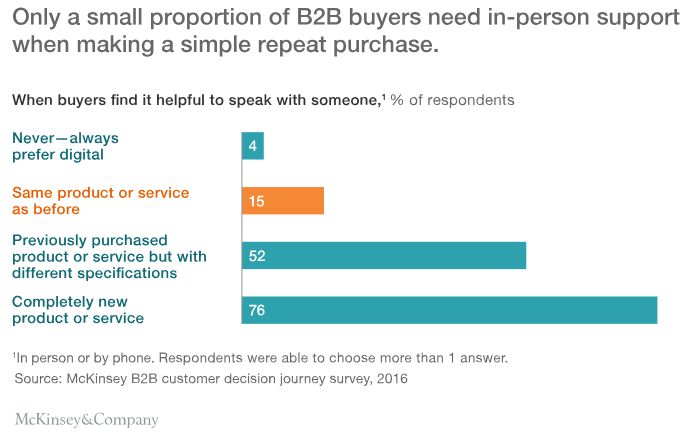In 2017, B2C eCommerce sales hit $2.3 trillion worldwide. B2B eCommerce, on the other hand, reached $7.7 trillion. That’s a 234.78% difference in market size. Huge right? Yet despite the scale of the opportunity, many B2B retailers have struggled to adapt the growing demands of the business consumer. Customer-centricity has long sat at the heart of B2C strategy, visit any retail conference and it’s impossible to go 30 secs without retailers emphasizing a customer-centric approach.
With endless choice, intuitive UX and super speedy fulfillment B2C retailers are innovating at a rapid pace. And not only that, enticed by the size of the opportunity, more and more retailers are entering the B2B space launching their own designated marketplaces and offerings. A clear threat if B2B retailers don’t act quickly.
The journey for B2B retailers is in many ways reminiscent of B2C players a few years ago who fought to master the connection between their online and physical stores. For B2B enterprises there is a conflict between physical and digital channels, between online sales and the sales forces’ with direct links to the customer.
Traditionally, it was believed that B2B buyers would be slow to embrace digital purchases, the sales were too complex and they preferred the reassurance of human to human interaction. Businesses like Amazon have changed this. They have shown that you can apply the same principals for selling that work in B2C, and see incredible results.
The Role of the Sales Force
The B2B Sales Force, such as sales representatives, telesales and key account managers has traditionally been integral to B2B buying decisions, complementing the more structured and formalized style of buying. In the age of digital-first, channel-agnostic, many businesses are struggling to identify where their sales force will fit in the new world order.
Despite the growing reliance on digital, customer face to face relationships are still essential, studies by Forrester and McKinsey confirm that B2B buyers :
- Prefer doing their own pre-sales research online
- Use digital to make non strategic and repeat purchase
- Want skilled sales reps for high-consideration purchases

In the study, McKinsey found that many customers were dissatisfied with the level of integration between online and offline. 46 percent said they found it difficult to compare product prices online and were frustrated when they couldn’t make a repeat purchase quickly and efficiently. They’ve come to expect B2C standard ease in all their purchases.
When engaging with B2B sales teams, 30 percent of buyers said they actually preferred to buy from distributors because manufacturers’ sales representatives took too long to get back to them. This was the number one complaint and often resulted in them switching suppliers. This tells us there is clearly an important role for sales teams and customer care in the B2B purchase journey, but it needs to adapt.
The Hybrid Model of Tomorrow
The role of the sales force team is changing, and it won’t be easy, but if businesses want to succeed it is an essential step in the journey to digitalization.
Sales forces and digital should not be considered as adversaries, but as allies. The sales force of tomorrow will be an augmented one, digital will be a complement and tool used to support physical sales forces. This physical contact is still essential for many purchasing experiences, just like B2C customers will demand an omni-channel experience, across all points of contact. It’s evolution, not extinction.
Digital adoption enables sales forces to:
- Focus on value add sales
- Never miss a sale with no more risk of stock-out
- Never have to say no to a customer (as the one-stop-shop experience offers the possibility to have virtually an unlimited offer)
Businesses should focus on removing the barriers to purchase, using sales teams to offer click to chat functionality on site and automating email reminders to encourage B2B buyers to make repeat purchases. Timing is of the essence. Customers won’t wait 20 minutes to hear back from an instant chat function, in this time they’ve made the purchase with a competitor.
The key to managing the change needed to keep pace in the digital age is to ensure businesses define the scope and responsibilities of their sales teams, giving training and tooling to empower them. As the old adage goes: “Things always seem impossible until they’re done.”
There is no denying that the strongest chance for B2B retailers to thrive is to embrace a hybrid sales force to create a stronger proposition.
Topics : Marketplaces B2B eCommerce
.jpeg?width=100&height=100&name=0%20(2).jpeg)
Written by Alfred Hawawini
Director of Business Development - B2B


